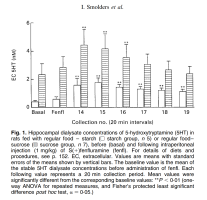JCastro
Member
- Joined
- Jun 8, 2016
- Messages
- 101
The rats who ate 50g/kg sucrose for 2 weeks had significantly higher hippocampal serotonin and a more potent response to the serotonergic drug fenfluramine, all compared to rats who ate 50g/kg starch for 2 weeks. The starch group had longer-lasting serotoninergic effects, but the sucrose group had more intense acute serotonin spikes.
Effects of dietary sucrose on hippocampal serotonin release: a microdialysis study in the freely-moving rat
Full paper: https://sci-hub.se/10.1079/bjn2001360
Effects of dietary sucrose on hippocampal serotonin release: a microdialysis study in the freely-moving rat
The effects of dietary supplementation with either sucrose or starch (50 g/kg regular food for 2 weeks) on central 5-hydroxytryptamine (5HT; serotonin) release were investigated in freely-moving rats. It has been suggested that the amount of transmitter that serotoninergic neurons release might be altered by food intake. We monitored the effects of sucrose and starch on concentrations of extracellular 5HT, its metabolite 5-hydroxyindoleacetic acid (5HIAA), gamma-aminobutyric acid (GABA) and dopamine in the hippocampus, using in vivo microdialysis. The major finding was that baseline levels of extracellular hippocampal 5HT in rats with ad libitum access to food supplemented with sucrose were significantly higher compared with the starch control group. We then verified that sucrose supplementation affected the potency of S(+)fenfluramine to increase hippocampal 5HT levels. In both groups of rats, acute intraperitoneal injection (1 mg/kg) of this anorectic drug induced a response curve of the extracellular hippocampal 5HT levels, with a shape that corresponded with earlier data for different brain areas often using up to 10-fold higher doses of S(+)fenfluramine. Nevertheless, we showed that throughout the experiment the absolute values of the sucrose response curve remained higher than in the starch group. On the other hand, S(+)fenfluramine exerted longer lasting effects in the starch group, as compared with the sucrose group. Significant decreases in levels of extracellular hippocampal 5HIAA levels following S(+)fenfluramine administration were simultaneously observed. A practical implication of the present findings is that dietary sucrose may bias the results of studies investigating brain serotoninergic mechanisms and the effects of (anorectic) drugs interacting with 5HT systems in the hippocampus.
Full paper: https://sci-hub.se/10.1079/bjn2001360


